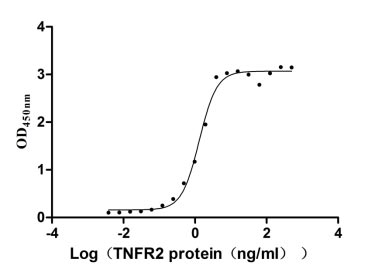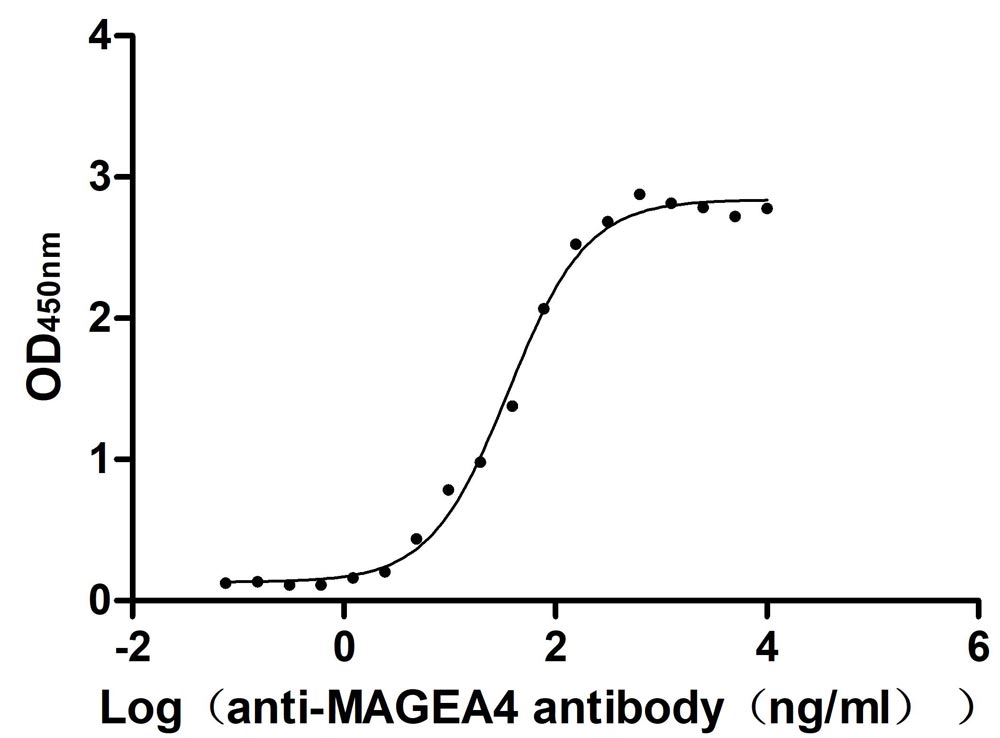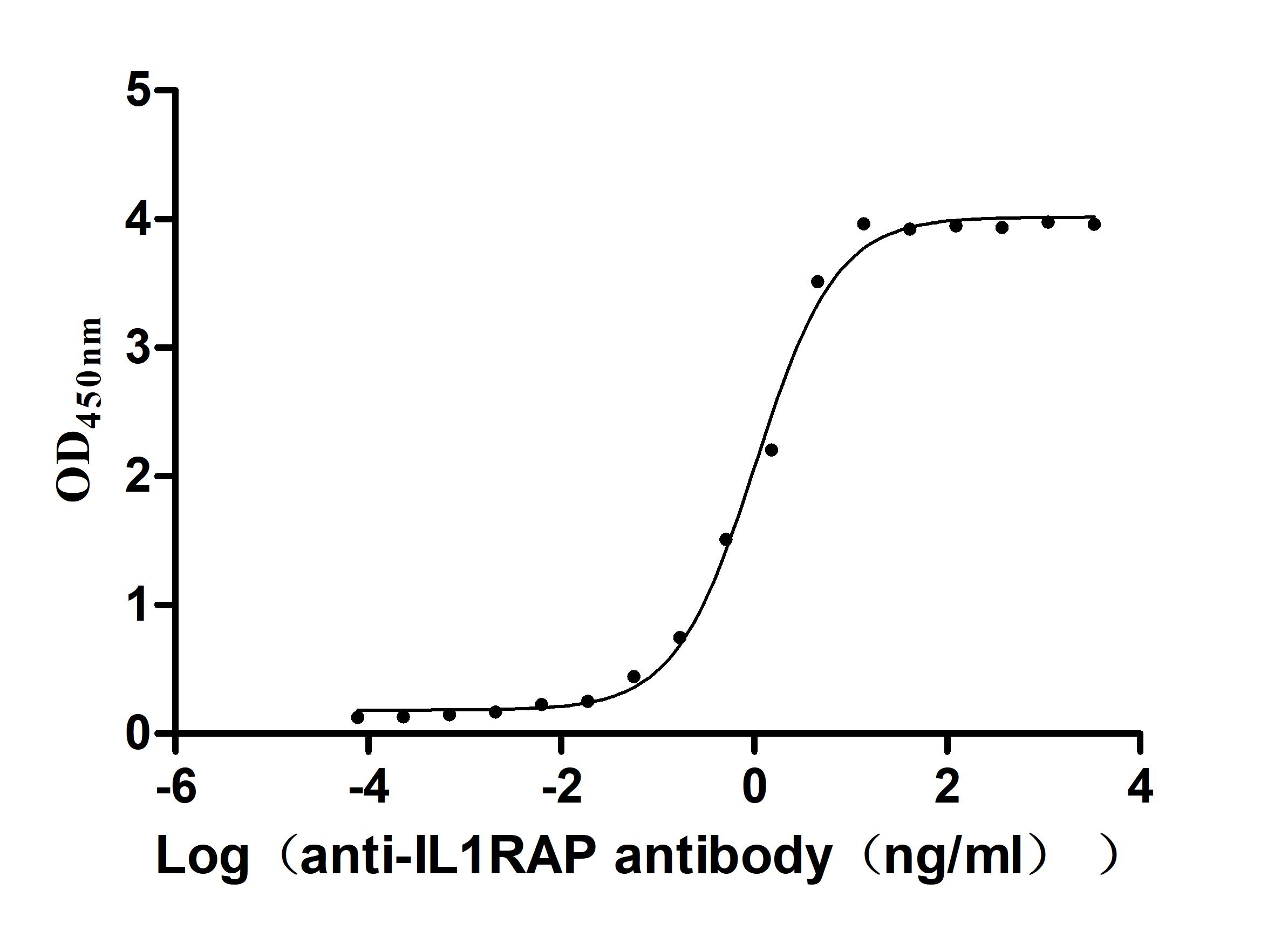Recombinant Human Ubiquitin carboxyl-terminal hydrolase 2 (USP2)
-
货号:CSB-YP025710HU
-
规格:
-
来源:Yeast
-
其他:
-
货号:CSB-EP025710HU
-
规格:
-
来源:E.coli
-
其他:
-
货号:CSB-EP025710HU-B
-
规格:
-
来源:E.coli
-
共轭:Avi-tag Biotinylated
E. coli biotin ligase (BirA) is highly specific in covalently attaching biotin to the 15 amino acid AviTag peptide. This recombinant protein was biotinylated in vivo by AviTag-BirA technology, which method is BriA catalyzes amide linkage between the biotin and the specific lysine of the AviTag.
-
其他:
-
货号:CSB-BP025710HU
-
规格:
-
来源:Baculovirus
-
其他:
-
货号:CSB-MP025710HU
-
规格:
-
来源:Mammalian cell
-
其他:
产品详情
-
纯度:>85% (SDS-PAGE)
-
基因名:USP2
-
Uniprot No.:
-
别名:41 kDa ubiquitin specific protease; 41 kDa ubiquitin-specific protease; Deubiquitinating enzyme 2; Ubiquitin carboxyl terminal hydrolase 2; Ubiquitin carboxyl-terminal hydrolase 2; ubiquitin specific peptidase 2; Ubiquitin specific processing protease 2; Ubiquitin specific protease 12; Ubiquitin specific protease 9; Ubiquitin specific protease, 41kD; Ubiquitin thioesterase 2; Ubiquitin thiolesterase 2; Ubiquitin-specific-processing protease 2; Ubiquitin-specific-processing protease testis; UBP-t; UBP2_HUMAN; UBP41; USP2; USP9
-
种属:Homo sapiens (Human)
-
蛋白长度:Full length protein
-
表达区域:1-605
-
氨基酸序列MSQLSSTLKR YTESARYTDA HYAKSGYGAY TPSSYGANLA ASLLEKEKLG FKPVPTSSFL TRPRTYGPSS LLDYDRGRPL LRPDITGGGK RAESQTRGTE RPLGSGLSGG SGFPYGVTNN CLSYLPINAY DQGVTLTQKL DSQSDLARDF SSLRTSDSYR IDPRNLGRSP MLARTRKELC TLQGLYQTAS CPEYLVDYLE NYGRKGSASQ VPSQAPPSRV PEIISPTYRP IGRYTLWETG KGQAPGPSRS SSPGRDGMNS KSAQGLAGLR NLGNTCFMNS ILQCLSNTRE LRDYCLQRLY MRDLHHGSNA HTALVEEFAK LIQTIWTSSP NDVVSPSEFK TQIQRYAPRF VGYNQQDAQE FLRFLLDGLH NEVNRVTLRP KSNPENLDHL PDDEKGRQMW RKYLEREDSR IGDLFVGQLK SSLTCTDCGY CSTVFDPFWD LSLPIAKRGY PEVTLMDCMR LFTKEDVLDG DEKPTCCRCR GRKRCIKKFS IQRFPKILVL HLKRFSESRI RTSKLTTFVN FPLRDLDLRE FASENTNHAV YNLYAVSNHS GTTMGGHYTA YCRSPGTGEW HTFNDSSVTP MSSSQVRTSD AYLLFYELAS PPSRM
-
蛋白标签:Tag type will be determined during the manufacturing process.
The tag type will be determined during production process. If you have specified tag type, please tell us and we will develop the specified tag preferentially. -
产品提供形式:Lyophilized powder
Note: We will preferentially ship the format that we have in stock, however, if you have any special requirement for the format, please remark your requirement when placing the order, we will prepare according to your demand. -
复溶:We recommend that this vial be briefly centrifuged prior to opening to bring the contents to the bottom. Please reconstitute protein in deionized sterile water to a concentration of 0.1-1.0 mg/mL.We recommend to add 5-50% of glycerol (final concentration) and aliquot for long-term storage at -20℃/-80℃. Our default final concentration of glycerol is 50%. Customers could use it as reference.
-
储存条件:Store at -20°C/-80°C upon receipt, aliquoting is necessary for mutiple use. Avoid repeated freeze-thaw cycles.
-
保质期:The shelf life is related to many factors, storage state, buffer ingredients, storage temperature and the stability of the protein itself.
Generally, the shelf life of liquid form is 6 months at -20°C/-80°C. The shelf life of lyophilized form is 12 months at -20°C/-80°C. -
货期:Delivery time may differ from different purchasing way or location, please kindly consult your local distributors for specific delivery time.Note: All of our proteins are default shipped with normal blue ice packs, if you request to ship with dry ice, please communicate with us in advance and extra fees will be charged.
-
注意事项:Repeated freezing and thawing is not recommended. Store working aliquots at 4°C for up to one week.
-
Datasheet :Please contact us to get it.
相关产品
靶点详情
-
功能:Hydrolase that deubiquitinates polyubiquitinated target proteins such as MDM2, MDM4 and CCND1. Isoform 1 and isoform 4 possess both ubiquitin-specific peptidase and isopeptidase activities. Deubiquitinates MDM2 without reversing MDM2-mediated p53/TP53 ubiquitination and thus indirectly promotes p53/TP53 degradation and limits p53 activity. Has no deubiquitinase activity against p53/TP53. Prevents MDM2-mediated degradation of MDM4. Plays a role in the G1/S cell-cycle progression in normal and cancer cells. Regulates the circadian clock by modulating its intrinsic circadian rhythm and its capacity to respond to external cues. Associates with clock proteins and deubiquitinates core clock component PER1 but does not affect its overall stability. Regulates the nucleocytoplasmic shuttling and nuclear retention of PER1 and its repressive role on the clock transcription factors CLOCK and ARNTL/BMAL1. Plays a role in the regulation of myogenic differentiation of embryonic muscle cells.; Circadian clock output effector that regulates Ca(2+) absorption in the small intestine. Probably functions by regulating protein levels of the membrane scaffold protein NHERF4 in a rhythmic manner, and is therefore likely to control Ca(2+) membrane permeability mediated by the Ca(2+) channel TRPV6 in the intestine.
-
基因功能参考文献:
- In general, we collect and summarize the factors involved in the alternative splicing of USP2 in this review to further understand the mechanism behind the USP2's alternative splicing PMID: 29230097
- s show here USP2 is expressed in quiescent and activated T-cells and its expression is 50% lower in CTCL cell lines (MyLa2000, SeAx and Hut-78) than in normal T-cells. PMID: 27351221
- The results show a connection between miR-125b and USP2 gene the etiology of psoriasis. They proceeded to show that modulation of nuclear factor kappa B-mediated inflammation is the likely mechanism through which this miRNA gene pair function PMID: 27479112
- the deubiquitinase USP2a translocates into the nucleus and binds to pY701-STAT1, and inhibits K48-linked ubiquitination and degradation of pY701-STAT1 PMID: 27434509
- ML364 also caused a decrease in homologous recombination-mediated DNA repair. These effects by a small molecule inhibitor support a key role for USP2 as a regulator of cell cycle, DNA repair, and tumor cell growth. PMID: 27681596
- Identify USP2 as a novel regulator of lipoprotein clearance owing to its ability to control ubiquitylation-dependent degradation of the LDLR by IDOL. PMID: 26666640
- Data suggest up-regulation of ASAH1 (acid ceramidase) activity by androgen in androgen-sensitive prostate cancer cells (but not other cancer cells) is mainly due to prolonged stability of ASAH1 by androgen-stimulated induction of USP2 expression. PMID: 25888580
- Modulation of USP-2 expression plays a crucial role in cell cycle regulation by leptin and adiponectin. PMID: 26033248
- Our findings suggest that USP2a mRNA may be considered as a diagnostic marker candidate for bladder cancer, in particular, to stratify MIBC patients with a more invasive phenotype. PMID: 26250800
- The present study showed that USP2 expression is associated with TNBC cell line's invasiveness and poor survival of breast cancer patients and may serve as a prognostic biomarker and therapeutic target for TNBC PMID: 25687182
- findings demonstrated that USP2b deubiquitinates K63-linked polyubiquitin chains from TBK1 to terminate TBK1 activation and negatively regulate IFN-beta signaling and antiviral immune response. PMID: 25070846
- Loss of USP2a expression is associated with glioblastoma. PMID: 24445145
- USP2a increases intracellular glutathione content, thus interfering with the oxidative cascade triggered by chemotherapeutic agents. PMID: 24071644
- USP2 and its substrate, fatty acid synthase (FASN), are over-expressed in glioma tissue. PMID: 23416128
- we have demonstrated that USP2a plays a negative regulatory role in IL-1beta- and SeV-induced NF-kappaB activation. PMID: 22611252
- USP2a plays an important role in TCR signaling by deSUMOylating TRAF6 and mediating TRAF6-MALT1 interaction PMID: 23264041
- USP2a antagonizes EGFR endocytosis and thus amplifies signaling activity from the receptor. PMID: 22710717
- TRAF2 inhibits USP2a effect on K48- but not on K63-linked ubiquitin chains. PMID: 22659130
- USP2a potentially mediates circadian disruption by suppressing the CRY1 degradation during inflammation. PMID: 22669941
- USP2a loss attenuates proliferation and migration in T24 human bladder cancer cells. PMID: 22370483
- a novel mechanism for the role of USP2a in mediating the stability of Aurora-A. PMID: 21890637
- Data indicate that CHIP and USP2 show antagonistic functions in the control of AIF-mediated cell death, and implicate the role of the enzymes as a switch for cells to live or die under stresses that cause truncated AIF release. PMID: 21293491
- Etiology of nodular fasciitis seems to involve USP6 transcriptional upregulation due to its fusion with a strong ectopic promoter (MYH9). PMID: 21826056
- the data support the conclusion that Usp2-45 action on epithelial Na(+) channel is promoted by various interactions, including through binding to Nedd4-2 PMID: 21478478
- our results implicate USP2 as a novel positive regulator of TNF-alpha-induced NF-kappaB signaling and show that its expression is altered in tumor cells. PMID: 21480224
- USP2-69 was upregulated in mesangial cells during mesangial proliferative glomerulonephritides in vivo and in vitro, which may relate to the proliferation of mesangial cells. PMID: 20403044
- Data show that ectopic expression of wild-type USP2a but not a catalytic mutant prevents Mdm2-mediated degradation of MdmX. PMID: 19838211
- Overexpression of Ubp41 is sufficient to elicit all features of apoptosis in human cells. PMID: 12566314
- the isopeptidase USP2a plays a critical role in prostate cancer cell survival PMID: 15050917
- USP2a is a novel regulator of the p53 pathway that acts through its ability to selectively target Mdm2. PMID: 17290220
- USP2 were over-expressed in ovarian serous cystadenocarcinoma tissues, suggesting that the activity of ubiquitin-proteasome system is obviously enhanced in ovarian cancer. PMID: 17553343
- Findings suggest that targeting USP2 is an effective approach to induce growth suppression in the cancer cells addicted to cyclin D1 expression. PMID: 19917254
显示更多
收起更多
-
亚细胞定位:Cytoplasm. Cytoplasm, perinuclear region.; [Isoform 4]: Nucleus. Membrane; Peripheral membrane protein. Cytoplasm.
-
蛋白家族:Peptidase C19 family, USP2 subfamily
-
组织特异性:Expressed in mesangial cells of the kidney and in different types of glomerulonephritides (at protein level).
-
数据库链接:
HGNC: 12618
OMIM: 604725
KEGG: hsa:9099
STRING: 9606.ENSP00000260187
UniGene: Hs.524085
Most popular with customers
-
Recombinant Human Tumor necrosis factor receptor superfamily member 1B (TNFRSF1B), partial (Active)
Express system: Mammalian cell
Species: Homo sapiens (Human)
-
Recombinant Human Glypican-3 (GPC3) (G537R), partial (Active)
Express system: Mammalian cell
Species: Homo sapiens (Human)
-
Recombinant Human Melanoma-associated antigen 4 (MAGEA4) (Active)
Express system: Mammalian cell
Species: Homo sapiens (Human)
-
Recombinant Human Cannabinoid receptor 1 (CNR1)-VLPs (Active)
Express system: Mammalian cell
Species: Homo sapiens (Human)
-
Recombinant Macaca fascicularis Trophoblast glycoprotein (TPBG), partial (Active)
Express system: Mammalian cell
Species: Macaca fascicularis (Crab-eating macaque) (Cynomolgus monkey)
-
Recombinant Macaca fascicularis C-type lectin domain family 4 member C(CLEC4C), partial (Active)
Express system: Mammalian cell
Species: Macaca fascicularis (Crab-eating macaque) (Cynomolgus monkey)
-
Recombinant Human Interleukin-12 receptor subunit beta-1(IL12RB1),partial (Active)
Express system: Mammalian cell
Species: Homo sapiens (Human)
-
Recombinant Macaca fascicularis Interleukin 1 receptor accessory protein(IL1RAP), partial (Active)
Express system: Mammalian cell
Species: Macaca fascicularis (Crab-eating macaque) (Cynomolgus monkey)



-AC1.jpg)
















